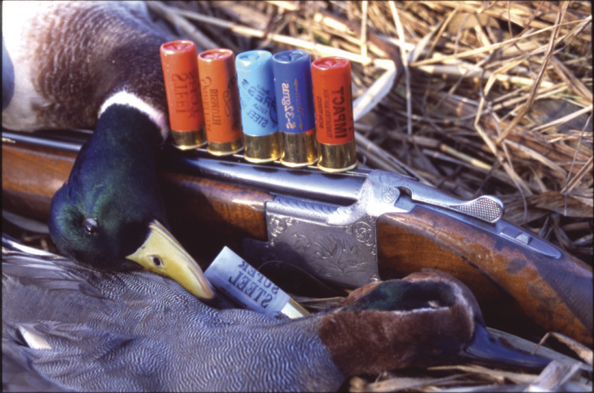Which shot for wildfowl?

Which shot for wildfowl?
Which shot for wildfowl?
WILDFOWLING calls for the heaviest loads used by UK sportsmen. Although inland ducks can usually be tackled with conventional game cartridges, geese call for stronger medicine – particularly on the foreshore.
How much shot?
As we suggested, an ounce or a little more will tackle ducks, but few sportsmen would even try to shoot a goose with less than 1.1/4oz.
Beyond that we are talking about some serious magnums carrying up to 1.3/4oz, plus 12-bore and 10-bore 3.1/2in cases carrying even more. The really big loads are usually reserved for the foreshore, where ranges are generally greater.
Shot material
When the British Government signed the African-Eurasian Waterbird Agreement in November 1999 it became illegal in England to shoot waterfowl with lead shot.
Regulations soon followed in Wales and Scotland, and more details are listed in our article about game cartridges.
In fact, the writing had been on the wall for lead for some years before 1999, and lead shot regulations in some Scandinavian countries, and the USA, preceded ours.
The American regulations specified steel as the only allowed alternative – and thank goodness the UK authorities did not follow suit.
UK cartridge manufacturers looked at several different alternatives.
The problem they faced was that practical, affordable alternative metals tended to be lighter than lead.
For instance, the lead used in cartridges, which contains a little antimony to harden it, has a specific gravity of about 11 or very slightly less, depending on the mix.
That means one cubic centimetre of cartridge lead weighs around 11 grammes.
Tin has a figure of 7.3, steel 7.5, and bismuth 9.3. With a huge specific gravity of around 15, tungsten looked super, except for the fact it is far too hard to use in a pure metallic form.
One answer was to mix tungsten powder with a plastic substance to form what is now known as tungsten polymer.
Tungsten polymer has a specific gravity of 10.8. British cartridge manufacturers soon abandoned tin as being too light.
Apart from its light weight when compared to lead, the hardness of steel means, in suitable wildfowling loads, it has to be shot through barrels carrying a special steel shot proof, which is more stringent than ordinary magnum proof.
In the early days of the regulations there were few, if any, guns available in the UK bearing this proof standard.
Thankfully, this situation has now been redressed – but it still behoves the owners of older magnums to check carefully on proofing before firing big steel loads. There are also maximum choke regulations which should be strictly adhered to.
Comparatively late on the lead substitute scene is Hevi-shot, for which the European distributors are Lyalvale Express. It is a combination of tungsten, nickel and iron, with a specific gravity of 12.
It is heavier than lead. The down side is it’s extremely hard, and very heavy loads of it require barrels with steel shot proof.
However, there is a range of cartridges which can be shot through guns with both normal and normal magnum proof.
The leading suppliers of non-toxic cartridges in the UK are Gamebore (tungsten matrix and steel), Lyalvale Express (Hevi-shot and steel), Eley Hawk (bismuth and steel), and Hull Cartridge Co (steel).
Their products range from cartridges in ordinary game loadings for 12 and 20-bores right through to 12-bore 3.1/2in magnums and 10-bore 3.1/2in shells.
What size?
Sixes, or fives if the range is on the extreme, are fine for inland ducks. Time was when wildfowlers used big ‘letter’ shot for geese.
This was partly due to the size of the bird, but also because they needed the hitting power at extended ranges.
Nowadays cartridge performance is better, and it is acknowledged that smaller shot provides denser patterns which deliver more pellet strikes at the target end.
No.3 is rated as quite adequate for most inland goose shooting, and few shooters go bigger than BB, even on the foreshore.
All of the above assumes the shooter is using either lead or one of the non-steel alternatives.
Steel, because it is so comparatively light and its hitting power per pellet falls off more rapidly with range, generally requires the use of bigger shot.
The main recommendation is to go up at least one shot size, and preferably two, when using steel at all but the shortest ranges.
Remember, though, because steel is so comparatively light you get more pellets per ounce.
How fast?
Heavy loads, in general, are rarely propelled faster than 1,350ft/sec. They also, generally, employ slower-burning powders than normal clay and game loads.
Heavy shot loads have to be accelerated more gradually than light ones, in order to keep pressures within safe levels.
Wad material
Steel and other very hard or abrasive substitutes demand special, thick-walled shot cup wads in order to avoid barrel damage.
These are generally made of plastic, although Gamebore have developed a successful biodegradable fibre shot cup.
Where shooters are allowed to use lead shot, the same rules apply as in game shooting – use fibre wads where they will fall on grazing land, or where the rules of the shoot demand them.
Bismuth can be fired with either fibre or plastic wads, but bismuth magnums are all loaded with plastic.








